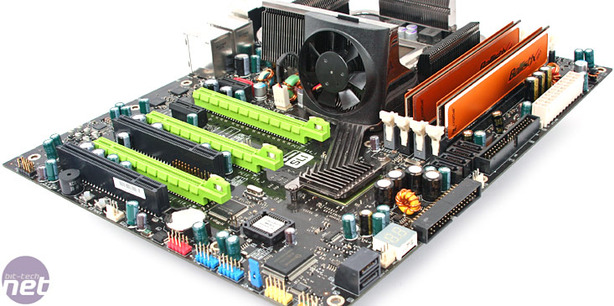Nvidia 790i Ultra SLI: Is It The Performance King?
Manufacturers: XFX, NvidiaUK Price (as reviewed): £223.19 (inc. VAT)
US Price (as reviewed): $349.99 (ex. Tax)
This one has been a long time coming – it is the battle of the performance behemoths. Regardless of cost, there are still some who will fork out for the best of the best of the best – but what does that get you? DDR2 or DDR3? More MHz, more cores or more GPUs? Tim will follow with an in-depth look at quad-SLI, three-way SLI and several CrossFireX configurations soon, but what basis should this cutting edge hardware be used on?
The current war of words between Nvidia and Intel has never been hotter; in fact, we’re sure there are supernovas with less vicious flair. While they both need each other to have their hardware work, they also both demand a better share of your wallet: Nvidia is trying to push GPUs as the central point of performance, whereas Intel is pushing CPU cores. Does the £900 quad-core QX9770 Extreme Edition matter or does a similarly clocked £185 dual-core processor suffice?
While we’ve already taken a first look at the XFX nForce 790i Ultra SLI motherboard, we were hesitant to do a performance analysis given the very high cost and generally negative community response.
We sat down and thought for a long while about how to approach this review: what advantage does buying an XFX nForce 790i Ultra SLI bring to the table? How does it compare to the competition? The nForce 790i Ultra SLI is meant to be the premium performance, overclocking and tweaking platform it has to offer – it's about getting the absolute most out of a system, and with that in mind you’ll also likely be filling it with graphics cards too. If someone was concerned with budget they’d buy a DDR2 nForce 780i SLI instead. However, that's not to say there isn't some intrinsic value – everything has to be worth the asking price. In that respect, is Nvidia's attitude to the high end right and does XFX effectively cater to it?
While we’ve used a single 9800 GTX for apples to apples comparisons, we’ve also included some GeForce 9800 GTX three-way SLI comparisons between 780i SLI and 790i Ultra SLI.
Ideally we hope to discover what makes the best platform for general use and gaming; does the extra performance warrant the extra cost? We spent an extensive amount of time manually optimising and tweaking each board to get the best performance out of it – lowering the memory latencies and maximising the performance with the given available BIOS options. Each board is certainly very "enthusiast" so we hoped to accommodate this.

Test Setup:
Motherboards:
- XFX nForce 790i Ultra SLI – £223.19 (inc. VAT)
- Gigabyte GA-X48T-DQ6 – £176.49 (inc. VAT)
- XFX nForce 780i SLI – £158.44 (inc. VAT)
- DFI LANParty LT X48-T2R – £164.44 (inc. VAT)
CPUs
- Intel Core 2 Extreme QX9770 (3.2GHz, 1,600MHz FSB, 12MB L2 cache) – £890.22 (inc. VAT)
- Intel Core 2 Duo E8500 (3.16GHz, 1,333MHz FSB, 6MB L2 cache) – £169.78 (inc. VAT)
Memory
- 2GB Corsair Dominator CM3X1024-1800C7D DDR3 – £280.99 (inc. VAT)
- 2GB Crucial Ballistix PC3-16000 DDR3 – £383.04 (inc. VAT)
- Both running at 1,600MHz (QX9770) and 1,333MHz (E8500) with the tightest timings possible.
- Kingston HyperX PC2-9600 DDR2 – £97.88 (inc. VAT)
- OCZ PC2-9200 FlexXLC Edition DDR2 – £103.05 (inc. VAT)
- Both running at 800MHz with the tightest timings possible.
Graphics:
- Nvidia GeForce 9800 GTX – £189.95 (inc. VAT)
- Three-way SLI Nvidia GeForce 9800 GTX – £569.85 (inc. VAT)
The QX9770 CPU is £720 more expensive than the E8500, but it does have two more cores, an unlocked multiplier and a faster native front side bus. In contrast, buying three GeForce 9800 GTX graphics cards instead of just one will set you back around another £380 – how much more does each of these get you for gaming or general productivity? True, the Q6700 has recently halved in price and overclocking a CPU is essentially free compared to adding physical CPU cores. However, both the E8500 and QX9770 are built on the new, cooler 45nm process and with high multipliers available should both push into the realms of 4.0GHz easily enough.
Common Components:
- PC Power and Cooling Silencer 750W PSU
- Seagate 7200.9 250GB SATA hard drive
- Windows Vista Home Premium 64-bit with Service Pack 1
- Nvidia Forceware 174.74

MSI MPG Velox 100R Chassis Review
October 14 2021 | 15:04









Want to comment? Please log in.